Last Updated on August 31, 2023 by David
Drive rapid growth by doing what you should be doing, better.

In the previous article about attracting shoppers using the right markers, Reamaze focused on helping eCommerce businesses recognize the importance of customer service, business practices, branding, and content as core pillars securing trust from new customers for a first purchase. However, getting shoppers to purchase is just the first step in building a successful business.
In a series of benchmark studies conducted by RJMetrics in late 2015, acquiring repeat customers is of utmost importance as you scale. Repeat customers specifically touch on metrics such as lifetime value and average order value. In addition, there are enlightening numbers in their findings.
Top performing companies generate 3.5 times more monthly orders. This difference does not come from more marketing dollars alone. Top performing companies are great at acquiring new customers, but they also have a product good enough to keep customers coming back again and again.— RJ Metrics
And that’s really where the rubber meets the road. How should eCommerce businesses keep customers coming back? Can you foster an experience for your first time purchasers where the end result is always a need to buy again? If you have competitors selling similar products, how can you foster brand loyalty so that the next considered purchase will come through your door, rather than your competitors’?
As software developers ourselves, we pay a lot of attention not just to the first overall experience, sometimes known as on-boarding, but also to what users do in our app immediately after becoming a “paid” user. The price of entry is merely the beginning. For us, we constantly measure how quickly a user can get acquainted to our product(s) and realize value.
For eCommerce, we should also strive to answer the same question:
“What is the most efficient way possible to help new customers love our brand and become repeat customers?”
There’s justification for this too, new customers are expensive to acquire. But excelling at getting existing customers to buy more is measurably cheaper, roughly 15% — 33% cheaper according to RJMetrics.
Still not convinced? BigCommerce also summarized a similar study conducted by RJMetrics and found that in terms of:
- average order values, top customers (repeat customers) generate somewhere between 3x to 5x more than your typical customer base.
- number of purchases, top customers make up at least 43% to 75% of overall sales.
- dollars spent, top customers spend almost 30x more than the average customer.
Simply put,
Companies that excel at turning one-time buyers into repeat purchasers have more profitable, sustainable businesses, with higher lifetime values. — RJMetrics
Successful eCommerce brands are also able to quickly ramp up repeat customer orders faster. That means they’re doing more than just creating a good product that people want to buy. They’re also actively engaging paying customers in a way that fosters more purchases. The graphic below is a visual representation of top performing eCommerce companies’ growth trajectory split by first time customers and repeat customers. Within 12 months of launch, repeat customers dominate the revenue growth curve by a significant margin. As you grow, more marketing means more costs. Increasing customers’ overall lifetime value is key.
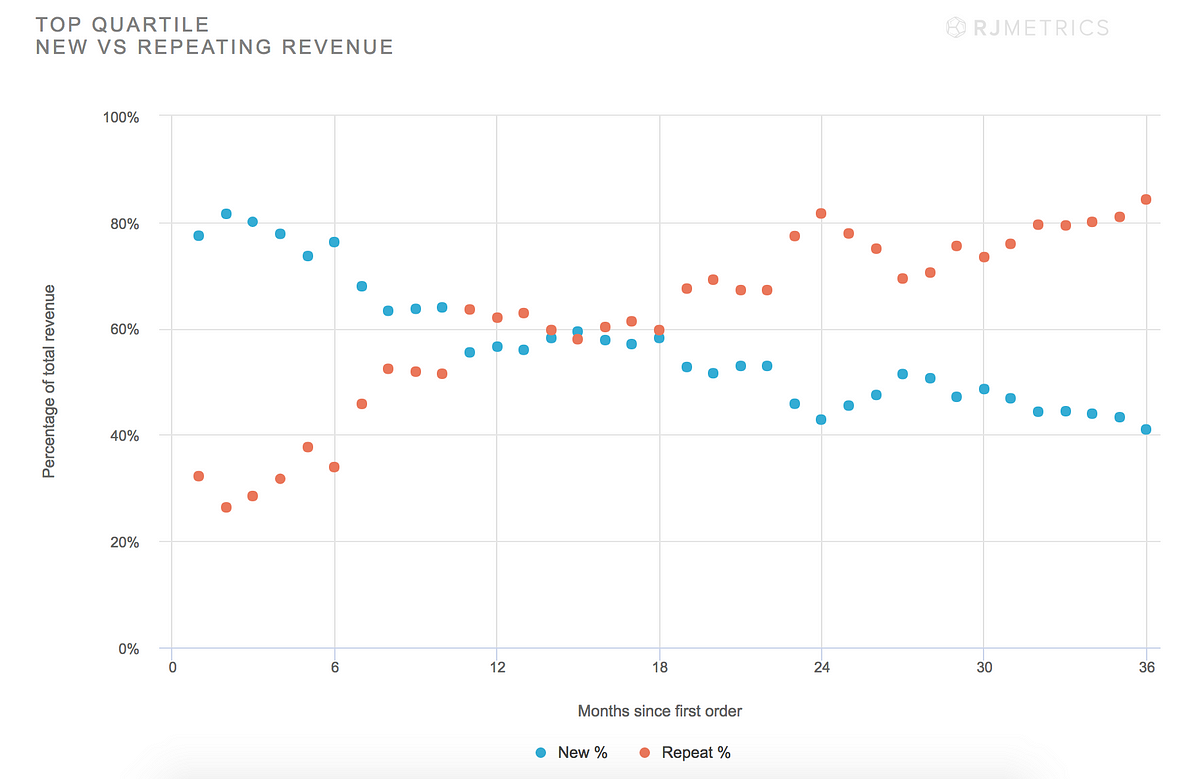
Mechanics
Pre-sales footwork
Before diving into building for loyalty, it’s important to have the basics for a first interaction done right. After all, the starting point for a healthy relationship with the customer is established with the first impression.
Preparing your store beforehand establishes the foundations of prolonged success in terms of attracting new buyers and also increasing the likelihood of fostering repeat buyers. Some of these pre-sales prep work is discussed here in this article, which we previously laid out in detail with examples of stores that nail the experience.
(re)Designing your checkout
There is a strong correlation between lowered shopping cart abandonment rates and repeat customers. And the first step to decreasing shopping cart abandonment is optimizing for a well designed checkout process. According to the Baynard Institute and Statista studies, average digital eCommerce shopping cart abandonment rates hover somewhere between 69%. That is a staggering statistic. Kissmetrics also help us visualize why people abandon shopping carts.
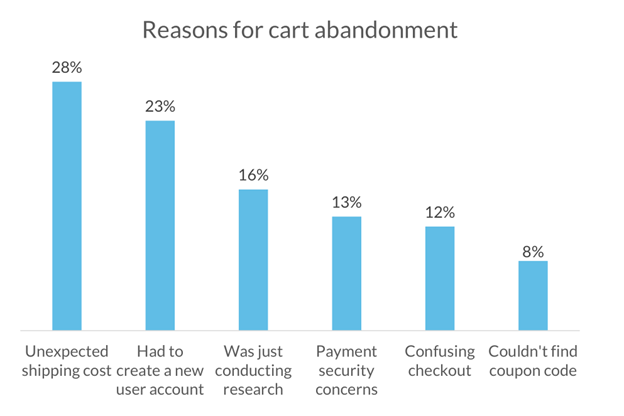
Designing your checkout to specifically address shopping cart abandonment even by a few percentage points can help lift revenue and give customers a great experience they won’t forget. There are few strategies to employ here.
Studies show that one page e-Commerce checkout pages have higher conversions as compared to a two page checkout. Bellroy’s single page checkout scraps features such as guest checkouts and opts for a single page experience that is smooth and efficient. Saving time while also reducing points of confusion has served Bellroy extremely well compared to other checkout experiences.
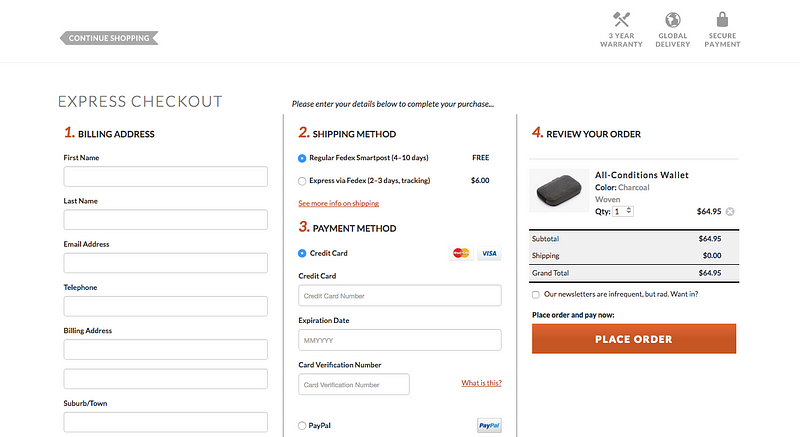
Single page checkouts are great but setting expectations for customers with top notch visual design can be just as effective. Made is a British furniture brand with contemporary design. The meticulous attention to design is carried throughout the brand including the checkout experience. Each step (such as shipping) is detailed, simple, and clear. Design consistency for Made helps push customers forward without ever removing them from what they’re looking for and making them more confident about their purchase decisions.
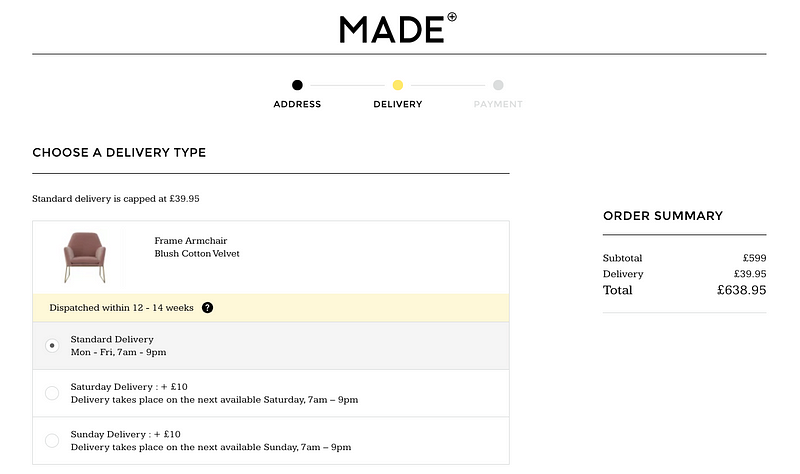
Crocs’ checkout page is a tried and proven design that touches on everything, just right. With plenty of options for payments, coupons, shipping, and cart sharing, Crocs’ checkout is designed to reduce shopping cart abandonment. In addition, product recommendations based on machine learning helps Crocs increase average order values effectively and efficiently through the experience.
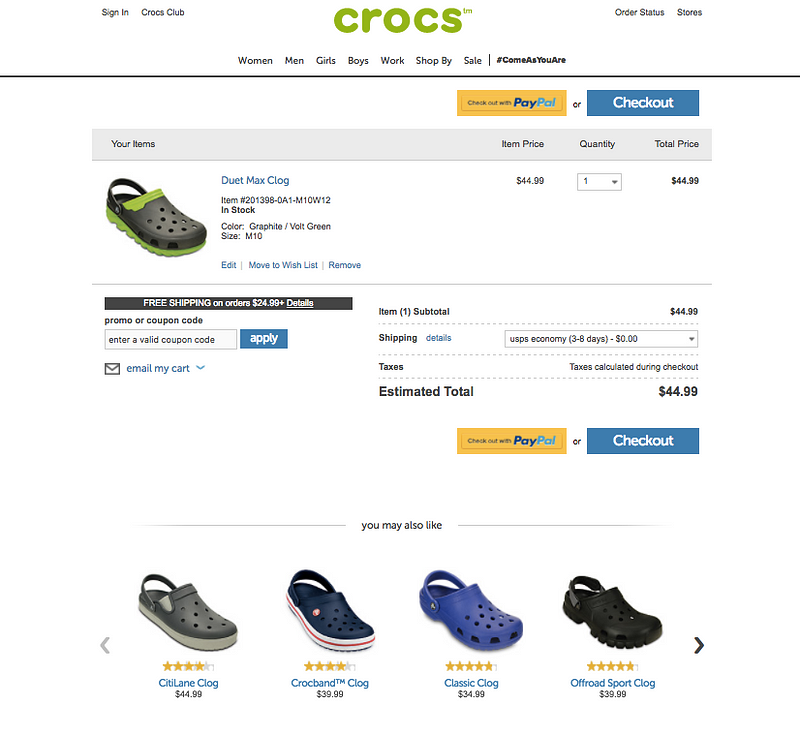
Stepping up your confirmation messaging
For many store owners, a “thank you” page doesn’t serve much of a purpose other than to to confirm a successful a purchase. However, a well thought out “thank you” page marks a pivotal moment in the customer experience and presents a unique opportunity to boost overall lifetime value.
By the time a customer has reached the point of a “thank you” message, they’ve already bought into your value proposition. They’ve stopped being a prospect and have become a paying customer. Why drop the ball here when it’s one of the simplest optimizations you can make?
Either way, the “thank you” page marks the next step in your sales process by taking full advantage of timely momentum. A polished “thank you” page should always strive to do the following three things:
- A personalized confirmation message that communicates what was accomplished.
- A clear call to action to help the customer orient themselves with future shopping opportunities.
- Specific instructions on what to do next or what will happen next.
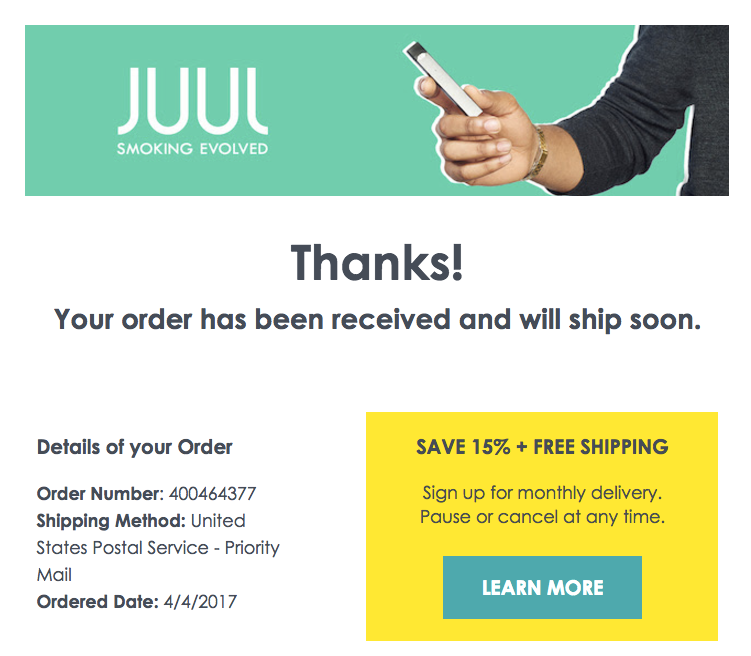
Thank-you pages need to be an integral part of your optimized conversion system. When used properly, it can continue to boost your revenue from first time customers and repeat customers long into the future. This phenomenon is sometimes known as the “foot in the door phenomenon”.
For experiment #1, those who actually took the survey and agreed to the simple request, 52.8% of them actually complied with the second request to let some stranger into their home for two hours to ransack their personal storage spaces. — Socially Psyched
By leveraging existing relationships, you can more easily convince willing patrons to purchase again.
Customer communications
Speaking of relationships, your best customers are, simply put, VIPs and should be treated differently than the average cohorts. When top customers spend 30x more than the average customer, their lifetime value of these customers isn’t just a bit better, it’s extraordinarily better. Combined with other statistics such as “companies focus on acquisition more than customer retention, even though it can cost 7x more to acquire new customer”, businesses need to think about brand loyalty optimizations for the best of the best.
The first solution most business gravitate toward is the tried-and-true email list, or some prefer to call the “newsletter”. While this off-the-shelf delivery vehicle is important and necessary for connecting with repeat customers, it is no longer the only or the best. Other solutions such as writing a personalized note, sending a gift, or inviting them to a special event are also great but often not “great enough” at scale.

Instead, consider these “non-traditional” strategies to give your customer relationships super powers:
- Make communications and engagement an inbound and outbound priority. Because all customers (known or not) have the potential to become a “top/repeat” customer, you need to proactively excavate their potential. Consider a real time chat solution that will not only make it easier for customers to contact you but also for you to reach out to customers actively browsing your products. Reamaze is just one solution out of many to pick from so feel free to experiment.
- Start leveraging powerful data you have on your customers. It doesn’t do you much good to have data on customers and not use them. Sometimes this can be to segment out cohorts for marketing purposes, other times, you might be able to use data to better empower your customer service teams to expedite service and offer a more personal experience. Whatever the cause, data is actually the foundation of good customer communications. For example, the Reamaze platform allows you to pass in customer data attributes dynamically for this exact purpose.
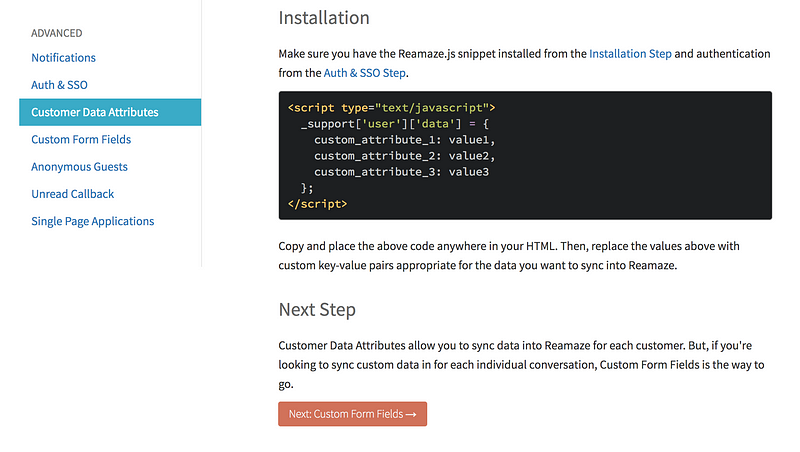
- Notifications. This is not generally something eCommerce store owners think about right off the bat. Our suggestion is to give it serious thought. There are various forms of notifications that can effectively double or triple your marketing ROI. What are notifications? A welcome message that reminds window shoppers that they can reach our if they have questions. A special coupon for repeat customers provided to them as they arrive on your site. A prompt for new customers as they’re about to leave you site. These are all notification formats you should adopt to ramp up your repeat customer base. We’ve got some ideas here as well.
- Include your top customers as a part of your content road map. Loyal, repeat customers are, by definition, participatory. Give your VIP customers the limelight and show them know how much you appreciate them. Investments in this area will generate enough reciprocity from your customers as they make marketing your brand a priority. This is an invaluable marketing asset. Give credit to your top customers’ advice, suggestions, and feedback. Nurturing customers to become loyal to your brand means you need to constantly improve. Top customers with unparalleled spending power and loyalty means you need to listen more closely to how they can influence your brand.
Polishing your metrics
Being sensitive and wary of business metrics (without getting stuck in the weeds) is a marker for a great eCommerce brand. Data-guided decision making not only abides by the scientific method but also funnels down through your business culture and ultimately, your ability to attract loyal customers. If you can’t measure something, you don’t have much of a chance at improving it. As Peter Drucker once put it:
“What gets measured gets improved.” — Peter Drucker
Getting or establishing a baseline is the first step to understanding where you are. Trends and peculiar data anomalies can usually reveal information about how customers are responding to your actions and/or changes. Without a baseline for which to build on top of and measure against, future optimizations are unlikely to help you increase metrics such as average order values, conversion rates, and ROI on advertising dollars.
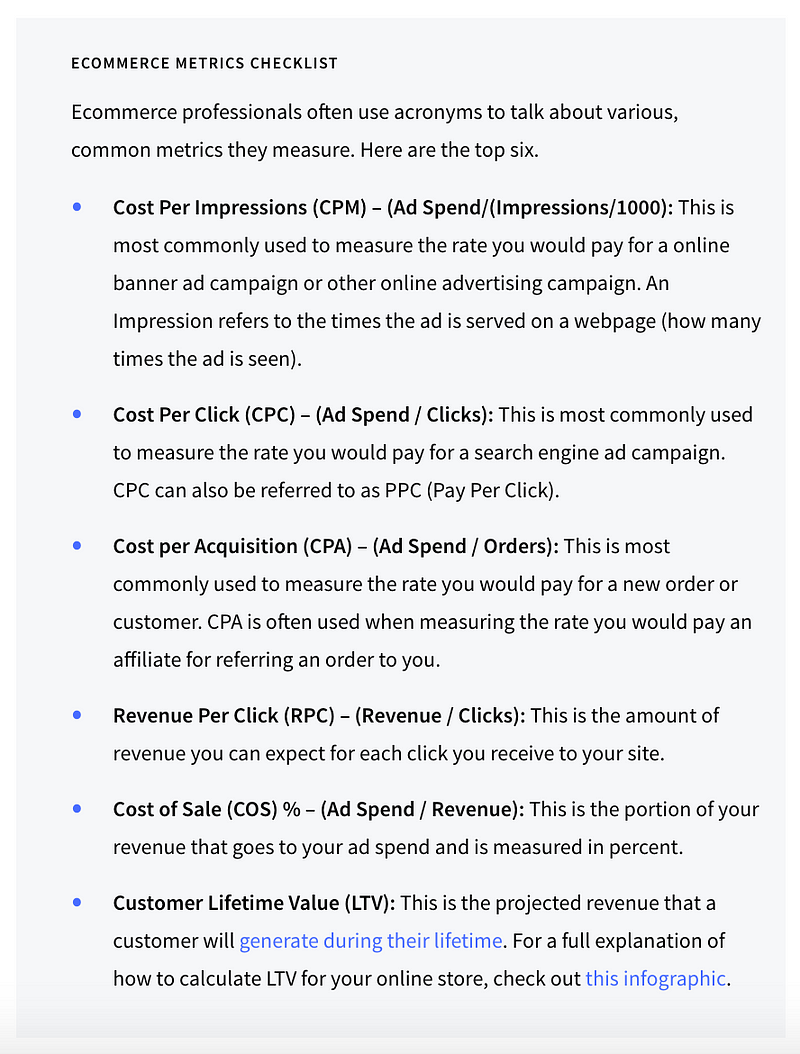
In terms of adjusting metrics, a business needs to stick with a consistent and measurable time frame. Data is accumulated daily but trends can only be seen maybe days, weeks, or even months out. Avoid reviewing and analyzing data simply out of curiosity.
By defining business goals (in this case, growing repeat customers) your bottom line will begin to play a bigger role in the overall picture. You may need to boost your website traffic and boost conversion rates and boost click-through rates all at the same time.
Premium packaging as content marketing
Fact: Premium packaging helps make a good first impression and increases brand ambassadorship.
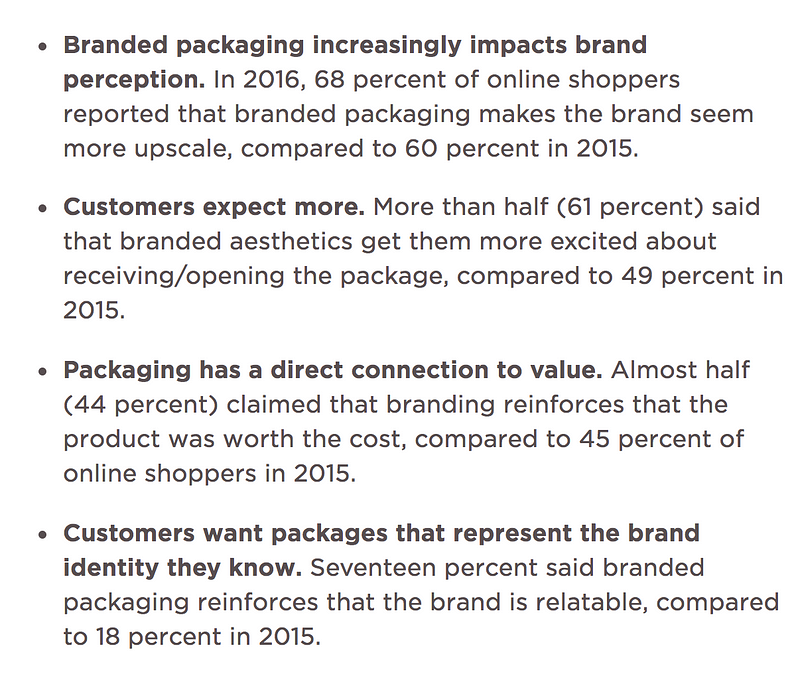
Is it a surprise that consumers care about aesthetics?
40 percent of online shoppers said they would be somewhat more likely or much more likely to purchase from a retailer that offers premium packaging. — DotCom Distribution
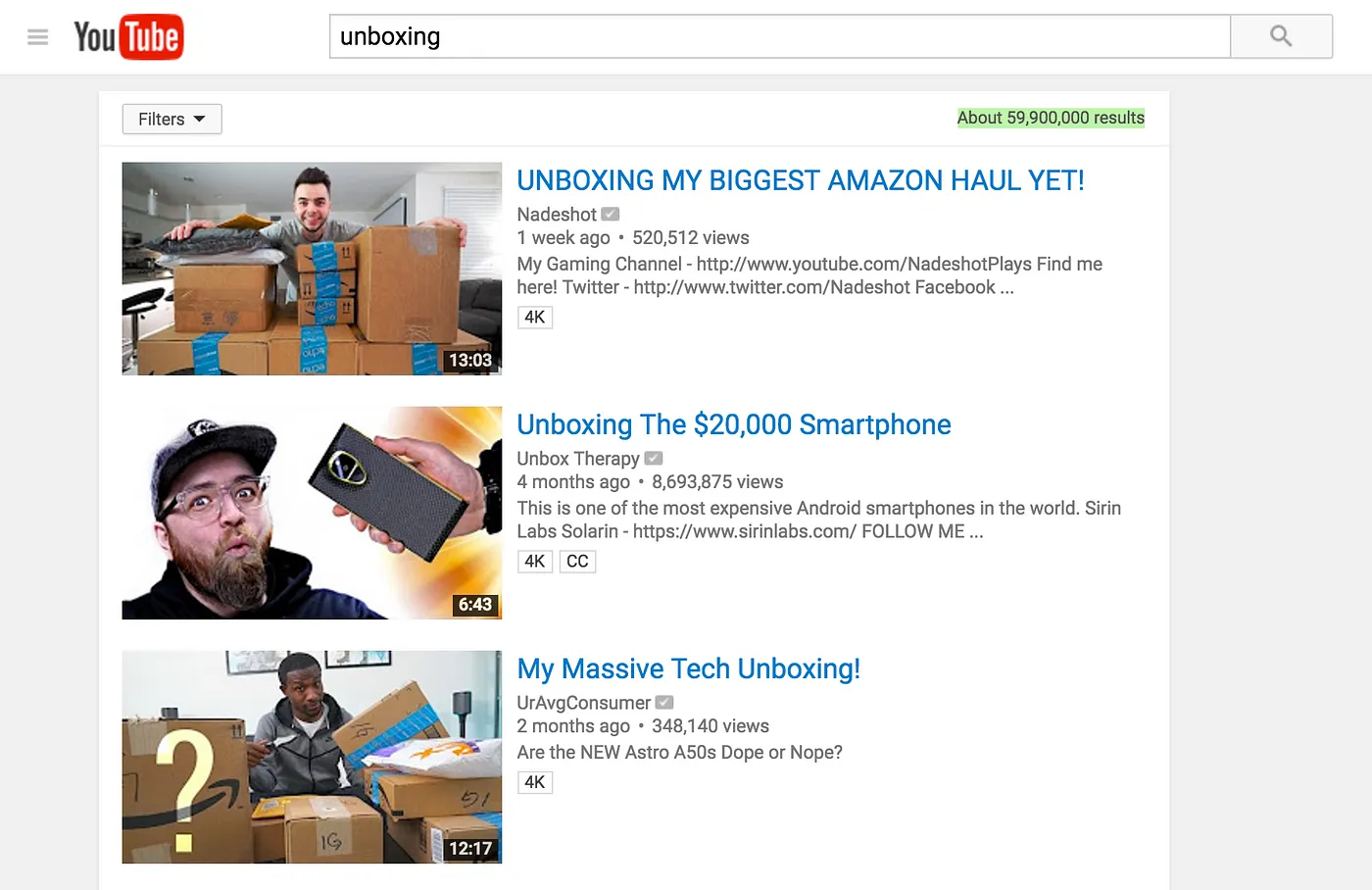
In order to leverage this mentality however, brands need to pay close attention to how their products are packaged and how the world might potentially see their product. Do a quick search on YouTube and more than 59 million results pop up for “unboxing”. There’s certainly something satisfying about living vicariously through someone else.
The advantage of content marketing is that there’s plenty of room for experimentation and the formulas for success vary wildly between businesses. Best practices apply but you can experiment liberally to see what works for you. If you sell a physical product, consider sponsoring some unboxings on YouTube with celebrity influencers. Of course, that means your product’s “box” should look enough to “unbox”; it needs to be an affair worth unboxing and NOT something like this:

Designing for customer loyalty
Finding repeat customers is about finding loyal customers. Like many things in business, it’s both science and art. Moving quickly to a revenue composition heavily based on repeat customers is a winning formula for almost all businesses.
Having good mechanics establishes a baseline for what you should be doing. Combined with good communications and presentation, you’re able to better measure the changes and optimizations you’re making to your overall sales funnel. This is by no means prescriptive. Rather, it’s a “jumping off” point for you to further evaluate and analyze your processes for finding repeat customers. Top eCommerce businesses don’t just stumble upon a dense populate of repeat customers. They’re just very good at designing customer loyalty.
Interested in what else we have to say? Make sure to recommend this article by clicking the heart and follow us for more stories about startup life, customer service, and tips on treating customers right.
You can also find our multi-brand, multi-channel customer service platform at https://www.reamaze.com. Follow @reamaze.

